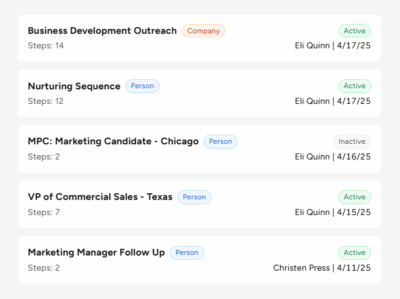When a client hires you to fill an open position, they already have a job title in mind for the future employee. But, that title might not be a good job title to use when searching for candidates.
You need to use the best job titles to improve your chances of finding more candidates who are qualified for the job.
Why good job titles are important
The job title is the first thing a candidate sees and knows about a job.
Think of the job title as the cover of a book. When you see the cover design, title, and author’s name, you can glean basic information about the book’s genre, topic, and basic storyline. Based on the book’s cover, you decide if you want to pick it up and learn more about what’s inside.
When a candidate sees a job title, they gather general information from it. They can guess about the experience needed, how much they’ll earn, the potential career path, and where they’ll fall within the company’s organizational structure.
Based on the information the candidate learns from the job title, they might move on or read the description for more details. The job title must hook the right candidates and make them interested in learning more about the job.
You might need to rewrite the job title your client gave you. Your client’s job title might use novelty or confusing terms. Work with your client to create a good job title that will make the right candidates interested in the position. Creating a good job title can help you find quality candidates faster.
Creating a job title
You must consider many things when creating great job titles. Use the following sections and job title examples to help you create effective job titles for your clients.
Determine the department
Consider the department where the new employee will be working (e.g., marketing, sales, customer support, accounting, etc.). It might be helpful to include the department in the title.
For example, instead of Associate you might say Sales Associate. Or, instead of Assistant to the Director, you could use Assistant to the Marketing Director.
Consider the organizational structure
Think about the organizational structure of your client’s business. The job title indicates the rank of the new employee within the structure.
Ask your client if the employee will report to anyone, or if anyone will report to the employee. Find out if the employee will have the power to make decisions.
Also, if an employee will meet with people outside of your client’s business, they might need a title that commands more authority. Even if the employee isn’t high up within the company structure, they might need an authoritative sounding title.
Most businesses have a typical ranking of titles within the organization. It normally follows this order:
- C-suite (CEO, CFO, etc.)
- President
- Vice President
- Director
- Manager
- Associate, Representative, Specialist
- Assistant
- Aide
Your client might have a slightly different structure, so make sure you talk with them.
Be specific
It’s best to be specific in the job title. Instead of generic terms that could apply to a variety of positions, use terms targeted for this position. Being specific will help you find candidates that are qualified for the position.
Let’s say you need to find a salesperson for your client. Don’t just list the job title as Salesperson. There are many types of salespeople. There’s a difference between a Senior Wholesale Account Coordinator and an Entry-Level Regional Sales Associate. Those two job titles will yield a different pool of candidates. Being specific will make sure you find the right ones.
Avoid abbreviations and acronyms
Abbreviations and acronyms can confuse candidates. They can make the job title look like alphabet soup.
Abbreviations and acronyms can also prevent potential candidates from finding the position on job boards. Unless the potential candidate types in the exact abbreviation you used, their search is unlikely to show your posting.
For example, you should spell out Senior instead of using Sr. And, you should write out Associate instead of using Assoc.
It is reasonable to use industry accepted acronyms. You can probably use RN instead of Registered Nurse, or CPA instead of Certified Public Accountant.
Remove confusing terms
Some businesses clutter their job titles with terms that only make sense to the people within the organization. Candidates will be confused by those terms, and will likely be deterred from reading more about the job.
Avoid insider terms, numbers, and symbols that people outside the business are unlikely to understand. Let’s say your client wants you to fill the opening for Team Lead III. That title might be confusing because it doesn’t tell what team, what the employee would be leading, or what the number three means. You might rewrite the title to read Software Product Development Lead.
Weigh company fit
Good job titles should match the company culture. If other employees have quirky, modern job titles, then it is probably fine if this employee has a unique title, too. But if the business has a strong corporate culture, the job title should probably be traditional.
Unique job titles
More companies are leaving behind the traditional job titles for more unique job titles, such as Analytics Guru.
Some businesses use unique job titles to look more hip. They’re typically better for more casual businesses.
Some unique job titles include:
- Doctor (Doctor of Customer Happiness)
- Guru (Systems Guru)
- Master (Marketing Master)
- Ninja (Software Ninja)
- Overlord (Operation Overlord)
- Rockstar (Rockstar Designer)
- Wizard (SEO Wizard)
In formal, corporate environments, the modern titles might not go over as well. The organizational structure isn’t as clear, so there might be confusion about who does what.
Candidates might also be confused by the titles. While some candidates will be intrigued by whimsical titles, others will be turned off because the terms can be difficult to understand.
Using the job title
Ultimately, you should use a job title that will help you find the most and best-qualified candidates.
It’s OK to source candidates using a title that’s different than what your client will give the employee. In some cases, it might be beneficial to do so. You client might want to label the employee as Sales Maestro or Salesperson II. But, potential candidates will likely overlook those titles. Instead, candidates might be more responsive to Junior National Sales Representative.
You will have more success finding candidates when the job title is descriptive and matches what potential candidates are searching for.
When you post a job or present it to a candidate, use the carefully crafted title you made. Make sure you log the title you’re using in your recruiting software so you can remember what it is, along with the client’s chosen title.
Keep in mind; a good title will only get you so far. It needs to be followed by a good job description. Learning how to write a job description that complements your polished job title will help attract the attention of the most quality candidates. You need to keep candidates’ interests once they get beyond the title.









